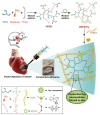Hydrogel Properties and Their Impact on Regenerative Medicine and Tissue Engineering
- PMID: 33302592
- PMCID: PMC7764781
- DOI: 10.3390/molecules25245795
Hydrogel Properties and Their Impact on Regenerative Medicine and Tissue Engineering
Abstract
Hydrogels (HGs), as three-dimensional structures, are widely used in modern medicine, including regenerative medicine. The use of HGs in wound treatment and tissue engineering is a rapidly developing sector of medicine. The unique properties of HGs allow researchers to easily modify them to maximize their potential. Herein, we describe the physicochemical properties of HGs, which determine their subsequent applications in regenerative medicine and tissue engineering. Examples of chemical modifications of HGs and their applications are described based on the latest scientific reports.
Keywords: hydrogel; physicochemical properties; regenerative medicine; tissue engineering.
Conflict of interest statement
The authors declare no conflict of interest.
Figures








Similar articles
-
Controllable fabrication of hydroxybutyl chitosan/oxidized chondroitin sulfate hydrogels by 3D bioprinting technique for cartilage tissue engineering.Biomed Mater. 2019 Jan 10;14(2):025006. doi: 10.1088/1748-605X/aaf8ed. Biomed Mater. 2019. PMID: 30557856
-
Methods to achieve tissue-mimetic physicochemical properties in hydrogels for regenerative medicine and tissue engineering.J Mater Chem B. 2024 Sep 11;12(35):8505-8522. doi: 10.1039/d4tb00716f. J Mater Chem B. 2024. PMID: 39149830 Review.
-
Bioprinting: From Technique to Application in Tissue Engineering and Regenerative Medicine.Curr Mol Med. 2023;23(9):934-951. doi: 10.2174/1566524023666220822152448. Curr Mol Med. 2023. PMID: 36017861
-
Design and characterization of an in vivo injectable hydrogel with effervescently generated porosity for regenerative medicine applications.Acta Biomater. 2022 Mar 1;140:324-337. doi: 10.1016/j.actbio.2021.11.036. Epub 2021 Nov 26. Acta Biomater. 2022. PMID: 34843951
-
Three-Dimensional Printing and Injectable Conductive Hydrogels for Tissue Engineering Application.Tissue Eng Part B Rev. 2019 Oct;25(5):398-411. doi: 10.1089/ten.TEB.2019.0100. Epub 2019 Sep 11. Tissue Eng Part B Rev. 2019. PMID: 31115274 Review.
Cited by
-
An Overview of Potential Applications of Environmentally Friendly Hybrid Polymeric Materials.Polymers (Basel). 2025 Jan 20;17(2):252. doi: 10.3390/polym17020252. Polymers (Basel). 2025. PMID: 39861324 Free PMC article. Review.
-
Exploring Cationic Guar Gum: Innovative Hydrogels and Films for Enhanced Wound Healing.Pharmaceutics. 2024 Sep 22;16(9):1233. doi: 10.3390/pharmaceutics16091233. Pharmaceutics. 2024. PMID: 39339269 Free PMC article.
-
Gelatin methacryloyl hydrogel as an injectable scaffold with multi-therapeutic effects to promote antimicrobial disinfection and angiogenesis for regenerative endodontics.J Mater Chem B. 2023 May 3;11(17):3823-3835. doi: 10.1039/d2tb02788g. J Mater Chem B. 2023. PMID: 36946228 Free PMC article.
-
Biomimetic Hydrogel Applications and Challenges in Bone, Cartilage, and Nerve Repair.Pharmaceutics. 2023 Sep 29;15(10):2405. doi: 10.3390/pharmaceutics15102405. Pharmaceutics. 2023. PMID: 37896165 Free PMC article. Review.
-
Collagen-based injectable and self-healing hydrogel with multifunction for regenerative repairment of infected wounds.Regen Biomater. 2023 Mar 7;10:rbad018. doi: 10.1093/rb/rbad018. eCollection 2023. Regen Biomater. 2023. PMID: 36974203 Free PMC article.
References
-
- Martínez-Martínez M., Rodríguez-Berna G., Bermejo M., Gonzalez-Alvarez I., Gonzalez-Alvarez M., Merino V. Covalently crosslinked organophosphorous derivatives-chitosan hydrogel as a drug delivery system for oral administration of camptothecin. Eur. J. Pharm. Biopharm. 2019;136:174–183. doi: 10.1016/j.ejpb.2019.01.009. - DOI - PubMed
Publication types
MeSH terms
Substances
Grants and funding
LinkOut - more resources
Full Text Sources

